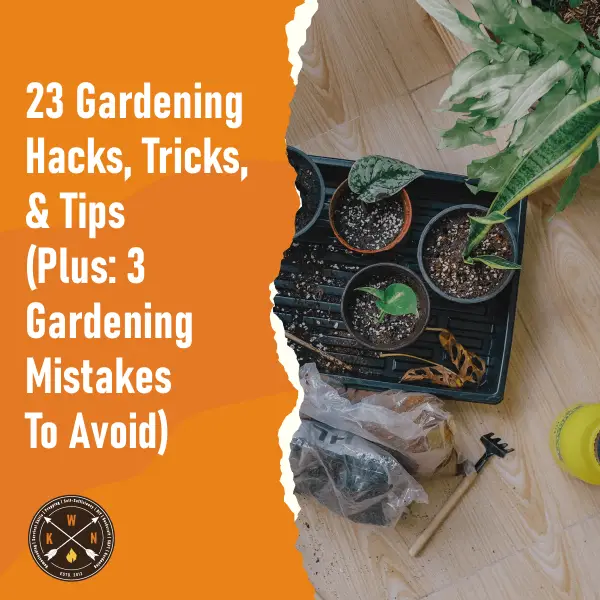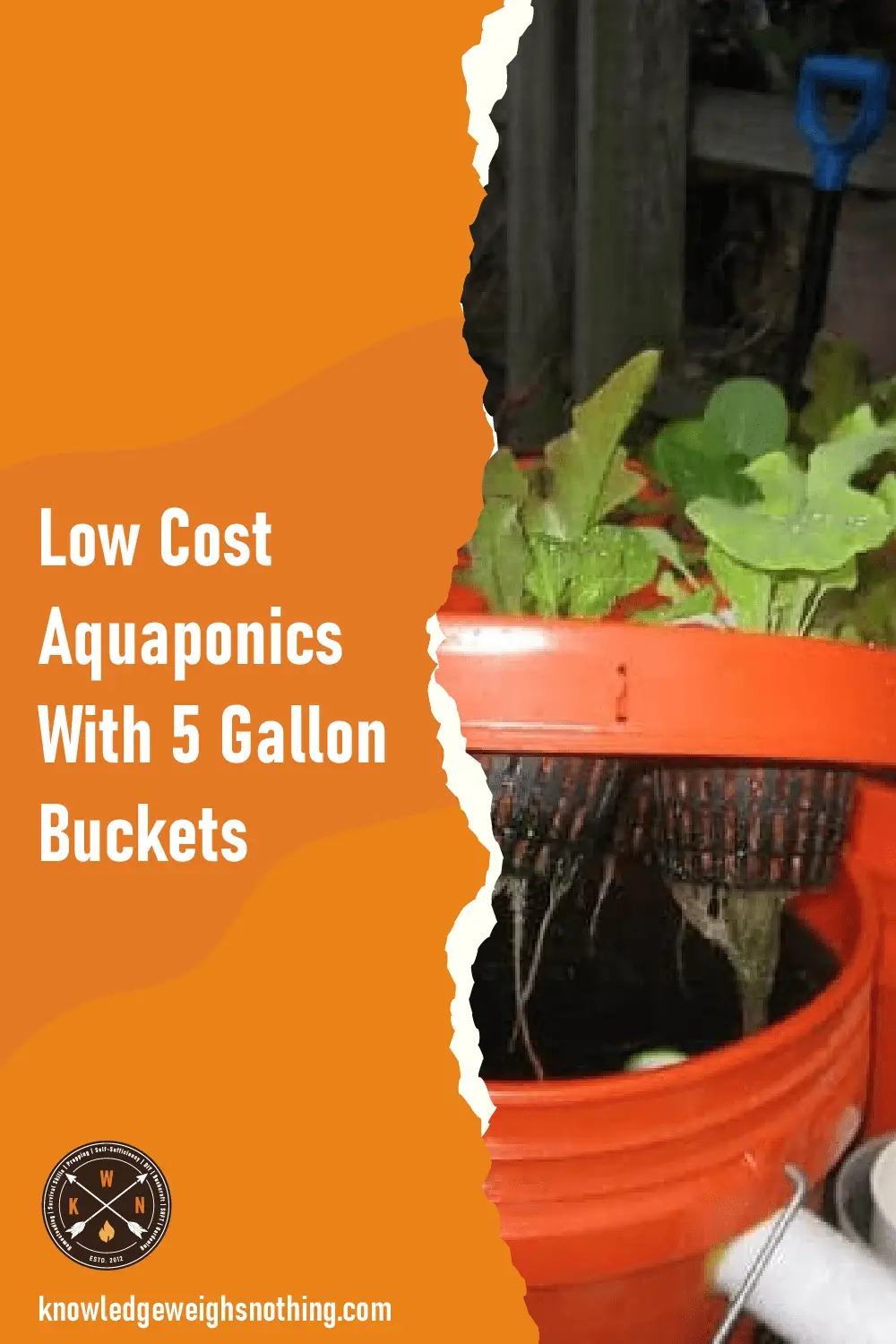
For some, gardening comes naturally — for millions of others, it’s an endless array of trial-and-error. Whether or not you were born with an instinctual green thumb doesn’t mean you have to settle for a lacklustre garden void of personality and beauty. If you’re searching for easy, innovative and amazing gardening tricks, continue reading for 23 insanely awesome hacks capable of turning your garden into an area of pride, beauty and fun!
The gardening tips, tricks, and hacks below are in no particular order. In fact, I think some of the best ones are further down the page!
Table of Contents
ToggleEnhance Crop Yield with the Alaska Grow Bucket
There are few advancements in the art of growing that have gained quite as much attention as the Alaska Grow Bucket. This simple system utilized contained growing environments while delivering concentrated amounts of plant feed through a gravity-fed vinyl tubing system. Moreover, this streamlined operation ensures plants are constantly watered, fed and drained through its self-watering irrigation system, which by the way does not require electricity. Through its unique design – and cost-effective materials – the Alaska Grow Bucket system can significantly improve the quantity and quality of crop yields without costing you an arm-and-a-leg.
Streamline Watering to Enhance Crop Yields
Tomatoes are one of the most common – and desired – vegetables for any home gardener. While these plants are relatively easy to cultivate, many find their annual yields disappointing. If you wish to dramatically enhance your overall yield, you must alter how you grow and water these delicious vegetables. This method, as outlined by Home Talk.
Begin by setting up a circular wire cage – typically for growing tomatoes. Next, drill three to five holes in large containers, such as a garbage can, and place the container in the middle of the growing area. Plant your tomato plants around the can. Fill the garbage can with compost and fill it with water. The water slowly leaks through the holes in the bottom of the container and feeds the root systems nutrient-rich water. Refill the container every two days and watch your tomato yield quadruple with this technique.
Grow Vertically – Simple and Yield Producing Strawberry Tube Planter
As the strawberry season quickly approaches, many are looking for ways to maximise their fruit production. One of the biggest problems many gardeners face – especially those in urban environments – is space. However, with the vertical strawberry tube planter, you can grow delicious strawberries within a fraction of the space required. How you may ask? By growing vertically. With materials such as PCV downpipes, rubber tubing and duct tape, you’re able to create a stable vertical growing space ideal for strawberries. While these growing spaces are available for commercial purchase, making your own is cheap, easy and actually fun.
Grow Potatoes Anywhere with Huge Yields – Living Fence Posts
Potatoes are one of the most flexible vegetables, and also one of the easiest to grow. However, as many urban farmers and those with smaller yards understand, these delicious and versatile vegetables typically won’t grow in their allotted space. However, much like the strawberry hack listed above, you can grow a significant potato harvest by choosing to go vertical.
The living fence post, as outlined by Growing Lots Urban Farm (unfortunately, this post is offline at the moment) showcases an easy and effective method for growing up to 25 pounds of potatoes within a wire cage no bigger than those used to grow tomato plants. By filling the cage with soil and surrounding it with hay, you can create the ideal growing environment for the potato plant. While this may be slightly on the advanced side for new gardeners, after a few tries you’ll soon have a vibrant and successful potato harvest.
Multiply Your Garlic Crop – With Only One Bulb
Transforming one garlic bulb into a thriving crop is far easier than you may think. Garlic is one of the most popular culinary ingredients; however, its use as a medicine is just as powerful – and supported by medical and Herbalism communities. Because of this, cultivating your own garlic crop should be a priority within your gardening list.
To start, simply take an organic garlic bulb and break it down to reveal its included garlic cloves. Each clove you see can be grown into a healthy garlic plant. Simply plant the garlic clove with the pointed tip pointing toward the sky. Now, cover the clove and watch your new supply of garlic grow!
Unleash Your Onions by Growing Vertically
As you can probably tell, vertical growing is one of the most effective ways to maximize harvests even in the smallest growing space. If you wish to increase your onion yields, then you should take a look at vertical growing as outlined by Fresh Organic Gardening. This method involves a plastic bottle filled with soil and onion sprouts. Throughout a simple process, you’ll soon have more fresh onions than you know what to do with.
Aquaponics System – An Easy and Effective Approach
Hydroponics is an advanced growing technique where plants thrive in water, not soil. If you’re looking to explore the next generation of farming, then this is an adventure for you. Aquaponic grow systems, as outlined by Five Gallon Ideas, is a fully organic way of growing almost any plant you can imagine. Because this method does not destroy soil, it’s a truly sustainable way to grow plants. While there are many hydroponic systems available on the open market, some of the most effective are those you make at home with common materials. Using the guide outlined in the aforementioned post, you’ll soon have a thriving hydroponic system without having to spend thousands on advanced products or technologies.
Lemon Rind Seedlings
Wish there was an easy way to start a seedling without having to purchase additional products? You’re in luck! This simple guide shows you how to support healthy seedlings within a lemon rind.
Gallon Jug Watering Spot
Perfectly watering your garden can be difficult if you don’t have the proper tools. The most successful homesteading or urban farming ventures are those which repurpose everyday items – like a gallon water or milk jug. This simple guide shows you how to make the perfect watering can with gallon jugs.
Gallon Jug Transformation Into a Gardening Shovel
Need effective gardening tools, but you’re low on cash? No problem, A Farm of Your Home features a simple way to transform old plastic gallon jugs into gardening shovels, trays and plant tags.
Store Bought Basil Plant Cuttings
One of the most exciting qualities of freshly bought herbs is their ability to be replanted for homegrown herbs. None are as successful at this venture as freshly bought basil. This easy to follow guide clearly explains how to plant store-bought basil cuttings.
Shower Caddie Hanging Gardens
Don’t have a lot of space for traditional gardens? Time to go vertical! This guide details how to transform an everyday shower caddie into a vibrant and productive hanging garden.
Shoe Rack Vertical Gardening
Urban farmers and homesteaders must maximize every square inch of their garden. Vertical gardening is the way to go, and This easy-to-follow guide gives step-by-step instructions for transforming your shoe rack into a high-yielding vegetable garden.
Towel Garden Watering Technique
Going out of town for a few days (or feeling a little lazy)? Don’t let your plants suffer. This insanely clever trick helps keep your garden freshly watered while you’re away through the use of everyday paper towels.
Sweeten Tomatoes With Baking Soda
Taking the tartness out of homegrown tomatoes has never been easier – or more cost effective. The Gardening Cook offers a simple guide to sweeten tomatoes without the use of expensive, or toxic, ingredients.
Prepare Pots for Optimum Plant Health & Growth
So you’ve just bought several gorgeous planting pots to add a sense of drama and beauty to your backyard? Before you insert your delicate plants, it’s imperative to prepare the pots. Instead of using chemical treatments, reach for items you already have. Combine equal parts of water, rubbing alcohol and white vinegar into a spray bottle. Apply a liberal amount into the pot and thoroughly scrub to remove clay pot salt deposits. Place the wet pot in direct sunlight to dry. Once fully dry, insert your plants and watch them grow.
Protect Your Plants from Winter’s Frozen Grasp
Sudden frosts and freezing temperatures can literally destroy young and mature plants. While there are many ways to protect your plants from freezing temperatures, save time and money by using gardening items you already have. Simply place a bucket or clay pot over the plants to protect them from frost and freezing temperatures.
Feed Plants with Vegetable Soup
Vegetable soup is a wonderful addition to any Fall and Winter meal plan; however, did you know there’s an effective fertilizer derived from the very plants you wish to grow? Next time you boil your vegetables, don’t throw away the used water. Rather, allow the water to cool to room temperature and pour directly at the base of the plants. The nutrients extracted from the boiling process work wonders to promote healthy growth and maximize fruit production.
Prevent Fungus With a Spot of Tea
Tired of fungus destroying your plants? Want an effective way to eliminate fungus without turning to synthetic and chemical treatments? If so, simply make a cup of chamomile tea. After brewing a batch of organic chamomile tea, pour the cooled tea into a spray bottle and apply directly along the base and branches of your plants. Perform this treatment once a week to ward off fungal growth. This is an especially effective gardening technique for young seedlings. Need a stronger anti-fungal treatment? Dissolve a single aspirin tablet in 1 quart of water and spray around the base of the plant or directly on fungus to immediately kill fungus spores while protecting the plant from future infection.
Keep Pot Soil Where It Belongs With Coffee Filters
If you’ve ever tried caring for potted plants, you’ve likely found the soil leakage to be a problem. If gone unchecked, essential nutrients can seep out of the potholes, which results in weak and damaged plants; no good for any plant, but especially herbs and small vegetable plants. Prevent this situation with a common household ingredient – coffee filters. Place an appropriately sized coffee filter along the base of the pot before adding soil. The filter keeps soil in the pot while allowing water and wastes to easily drain.
BONUS Section: The Top 5 Gardening Mistakes
There’s a lot to learn about gardening, and while some people are naturally inclined with a green thumb, the rest of us learn through a never-ending series of trial-and-error. Although there are literally thousands of pages detailing what you must do to keep your garden healthy and happy, there aren’t very many resources detailing what you should never do.
If you’re just starting out in the world of gardening and wish to make this transition as seamless and productive as possible, then continue reading to uncover the top 3 most common gardening mistakes, which are guaranteed to ruin your garden.
Mistake #1 | Grand Visions Without Grand Knowledge
Perhaps one of the most common mistakes made by new gardeners is simply starting off too big. While you may have a grand vision of what you wish your garden to look like, without the proper experience, equipment and knowledge, what starts off with good intentions will quickly lead to frustration, headaches and a garden that’s disappointing.
The best way to begin a gardening strategy is to start small within your first year. Use this as a growing opportunity, for not only your plants but also your knowledge. You’ll find honing your gardening skills to be far easier on a smaller scale. As you grow in your abilities, slowly add more plants and begin detailing the garden of your dreams.
Mistake #2 | Foregoing Sunlight Recommendations
Sure, there’s a little wiggle room when it comes to the exact amount of sunlight needed to grow healthy, vibrant plants. However, the most common mistake made by novice gardeners is to completely ignore light requirements. Every plant features unique light requirements, and if you do not actively work to satisfy these requirements, then you’ll soon find yourself standing among a garden of dead or ailing plants.
The first step in preventing this problem is to learn the layout of your garden. How much sunlight do specific areas receive? It’s only with this knowledge that you are able to purchase plants and position them in the best location based upon their unique needs.
Mistake #3 | Over or Under-Fertilizing Your Plants
There are few mistakes capable of completely destroying the health and yield of your garden than over or under-fertilizing the plants. Although fertilizer is an essential component for a healthy and happy garden, misuse of its ingredients can literally burn plants at their core.
The variables that go into determining the best type of fertilizer are just as varied as the plants themselves. Too much, too little, incorrect timing and the wrong type of fertilizer will prove detrimental to the health of your garden. For example, all plants thrive on nitrogen to grow. Because of this, many fertilizers feature high-nitrogen content. While certain plants, such as lettuce, require high nitrogen fertilizers for optimum growth, the same amount of fertilizer will stimulate excessive top growth for other plants, which will reduce its fruiting potential.
Therefore, it’s imperative that you go easy on the fertilizer and do your research regarding the exact amounts needed for specific plants.




